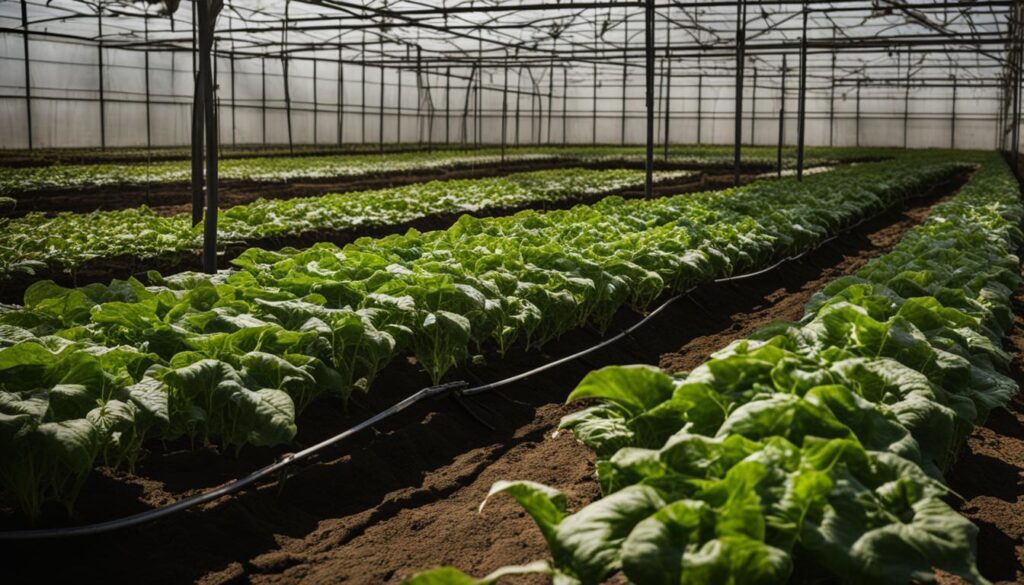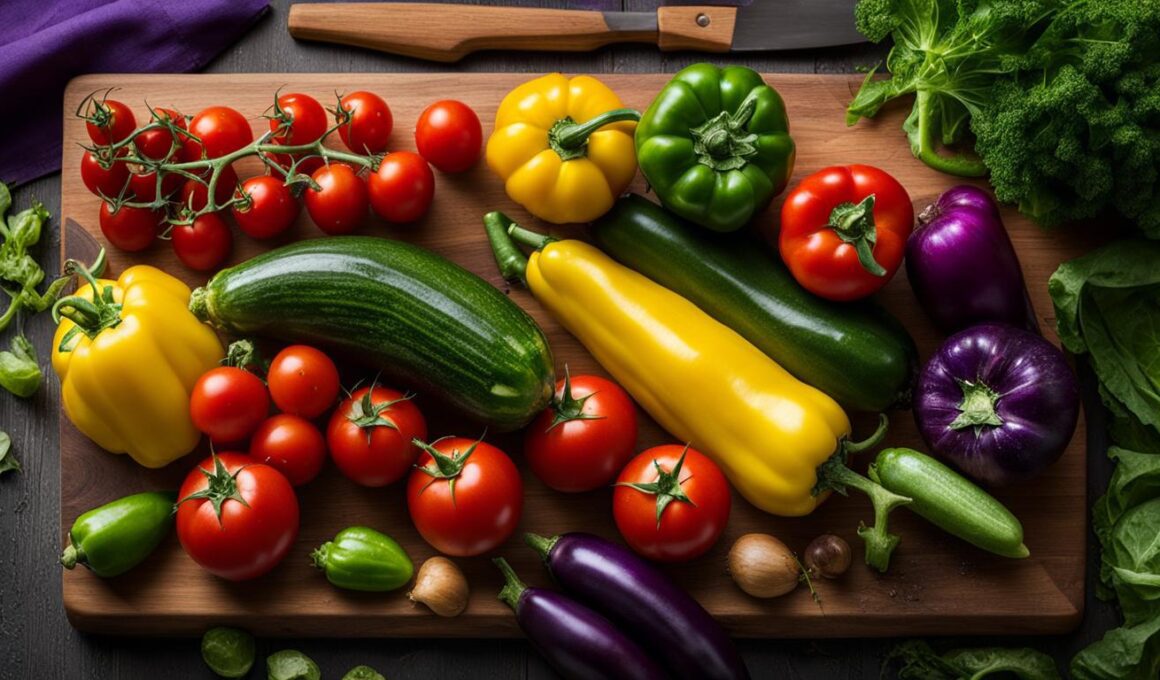Welcome to our article on the health benefits of greenhouse vegetables. If you’re wondering whether these year-round favorites are good for you, we’ve got the answers. Greenhouse vegetables are known for their controlled growing conditions and availability throughout the year. But how do they stack up in terms of nutrition and overall health benefits? Let’s dive in and find out.
Post Summary:- Greenhouse vegetables provide year-round availability and controlled growing conditions.
- They may have slightly different nutritional profiles compared to open-air field-grown vegetables.
- Despite nutritional variations, greenhouse vegetables still contain essential minerals and nutrients.
- Sustainable practices, such as water conservation and integrated pest management, are prioritized in greenhouse growing.
- Common challenges in greenhouse vegetable production include the spread of pathogens and disease outbreaks.
The Benefits of Greenhouse Produce
When it comes to greenhouse produce, there are several key advantages that make it a popular choice for many consumers. One of the standout benefits is the ability to enjoy fresh vegetables year-round. Unlike traditional growing methods, greenhouse-grown produce is not as reliant on external climates. Thanks to the controlled high-tech environment, greenhouse growers can provide a consistent supply of fresh vegetables regardless of the season.
Not only does the controlled environment of greenhouses ensure year-round availability, but it also allows for greater consistency in the quality and flavor of the produce. The uniform growing conditions result in vegetables that are not only visually appealing but also have a consistent taste. So whether you’re enjoying a tomato in the middle of winter or a cucumber in the heat of summer, you can expect the same great flavor every time.
Another advantage of greenhouse produce is the focus on sustainable practices. Many greenhouse operations prioritize resource conservation and implement advanced techniques to minimize waste. For example, rainwater collected from the roofs of the greenhouses is often used to water the plants, reducing the demand for external water sources. Additionally, integrated pest management techniques are employed to minimize the use of pesticides, further reducing the environmental impact of greenhouse growing.

Overall, greenhouse produce offers fresh, high-quality vegetables year-round, thanks to the controlled environment in which they are grown. With a focus on sustainability and consistency, greenhouse growers ensure that consumers can enjoy nutritious and delicious vegetables while minimizing the impact on the environment.
The Benefits of Greenhouse Produce
Nutritional Differences in Greenhouse Vegetables
When comparing greenhouse vegetables to their open-air field-grown counterparts, there are some slight nutritional differences to consider. A study found that greenhouse vegetables had lower levels of chlorophyll, total sugar, and crude fiber. This can be attributed to the lower wind speed and inadequate illumination in greenhouse environments, which impact photosynthesis and water uptake in plants. However, despite these variations, greenhouse vegetables still provide essential minerals and nutrients necessary for a balanced diet.
While the levels of chlorophyll, total sugar, and crude fiber may be lower in greenhouse vegetables, they still contain important minerals such as potassium, calcium, magnesium, iron, zinc, copper, and phosphorous. These minerals are vital for various bodily functions and contribute to overall health and well-being. So, even though there may be slight differences in nutritional composition, greenhouse vegetables remain a healthy choice.
It’s important to note that the nutritional differences between greenhouse and open-air field-grown vegetables are relatively minor. Both options offer their unique benefits and can be part of a nutritious diet. The choice between the two ultimately depends on personal preference and availability. Whether you choose greenhouse vegetables or not, the key is to consume a variety of fruits and vegetables to ensure a well-rounded nutrient intake.
Remember, the nutritional value of any vegetable can be enhanced by cooking methods such as steaming or sautéing, which help to retain important nutrients. Regardless of whether you opt for greenhouse or open-air field-grown vegetables, incorporating a variety of them into your diet will provide you with a wide range of essential nutrients.
| Nutrient | Greenhouse Vegetables | Open-Air Field-Grown Vegetables |
|---|---|---|
| Chlorophyll | Lower | Higher |
| Total Sugar | Lower | Higher |
| Crude Fiber | Lower | Higher |
| Potassium | Presence | Presence |
| Calcium | Presence | Presence |
| Magnesium | Presence | Presence |
| Iron | Presence | Presence |
| Zinc | Presence | Presence |
| Copper | Presence | Presence |
| Phosphorous | Presence | Presence |
Sustainable Practices in Greenhouse Growing
When it comes to greenhouse growing, sustainability is a top priority. Growers utilize various practices to minimize their environmental impact and conserve resources. One of the key sustainable practices in greenhouse growing is the use of hydroponic systems. These systems require significantly less water compared to traditional field crops, with some operations using up to 95% less water per pound of yield.
In addition to reducing water usage, greenhouse growers also focus on integrated pest management techniques. Instead of relying solely on pesticides, growers introduce beneficial insects like ladybugs to control harmful pests. This approach not only minimizes the use of chemicals but also promotes a more natural and balanced ecosystem within the greenhouse.
“By implementing sustainable practices, greenhouse growers are able to produce high-quality vegetables while minimizing their environmental impact.”
Furthermore, greenhouse growers often collect rainwater from the roofs of their greenhouses to water the plants. This practice not only conserves water but also reduces the reliance on external water sources. Additionally, by reusing water and implementing efficient irrigation systems, greenhouse growers can effectively manage water usage and reduce waste.
Comparing Water Usage in Greenhouse Growing
| Greenhouse Growing Method | Water Usage (per pound of yield) |
|---|---|
| Hydroponic Systems | Significantly less water compared to field crops |
| Traditional Field Crops | Higher water usage due to natural conditions |
By implementing sustainable practices, greenhouse growers are able to produce high-quality vegetables while minimizing their environmental impact. From water conservation to integrated pest management, these practices ensure that greenhouse growing remains a sustainable and responsible method of food production.
Common Problems in Greenhouse Vegetable Production
Greenhouse vegetable production, despite its numerous benefits, is not without its challenges. Growers face common problems that can impact the health and productivity of their crops. Understanding these challenges is crucial for implementing effective preventative measures and ensuring successful greenhouse vegetable production.
One common problem in greenhouse vegetable production is the spread of seed-borne and soil-borne pathogens. These pathogens, such as fungi and bacteria, can cause diseases that affect the plants’ growth and yield. Pathogens like Alternaria, Bipolaris, Cercospora, Colletotrichum, Fusarium, Phytophthora, Pythium, and Rhizoctonia are known to affect greenhouse-grown vegetables. To mitigate the risk of disease outbreaks, growers should use new potting medium and containers, optimize water and fertilizer usage, and implement proper disease management protocols.
Another challenge in greenhouse vegetable production is the control of pests. Pests can cause significant damage to crops and reduce their quality and yield. To manage pests, growers often rely on a combination of cultural management and biological control methods. Maintaining a clean and healthy growing environment is important to reduce the risk of pest infestations. Introducing beneficial insects like ladybugs and using bumblebees for natural pollination can help control harmful pests. In some cases, growers may also use approved biopesticides targeted at specific pests.
By addressing these common problems in greenhouse vegetable production, growers can minimize the risks and maximize the potential of their crops. Implementing preventative measures and adopting sustainable practices will contribute to the overall success and sustainability of greenhouse vegetable production.

Pest Management in Greenhouse Vegetable Production
When it comes to greenhouse vegetable production, effective pest management is crucial for maintaining healthy and high-yielding crops. By implementing a combination of cultural management practices and biological control methods, growers can minimize the risk of pest infestations and reduce the reliance on chemical pesticides.
To create a clean and healthy growing environment, it is important to start with proper sanitation practices. This includes regularly cleaning and disinfecting the greenhouse structures, equipment, and tools. Removing plant debris and weeds from both inside and outside the greenhouse can also help eliminate potential pest habitats.
One effective method of pest control in greenhouse vegetable production is the introduction of beneficial insects. These “good bugs” can prey on harmful pests, keeping their populations in check. For example, ladybugs are often released to control aphids, while parasitic wasps can target pests like whiteflies and thrips. These biological control agents offer a natural and sustainable alternative to chemical pesticides.
| Pest | Beneficial Insect |
|---|---|
| Aphids | Ladybugs |
| Whiteflies | Parasitic wasps |
| Thrips | Parasitic wasps |
Integrated pest management (IPM) techniques are also widely used in greenhouse vegetable production. IPM involves monitoring pest populations and taking action only when necessary to prevent economic damage. This approach focuses on minimizing the use of pesticides and implementing alternative pest control methods, such as trapping, physical barriers, and cultural practices.
By adopting these pest management strategies, greenhouse vegetable growers can create a balance between pest control and environmental sustainability. This not only helps protect the crops from pests but also promotes healthy and nutritious vegetables for consumers to enjoy.
Can Potatoes be Grown in a Greenhouse to Reproduce?
Greenhouses provide an ideal environment for growing potatoes. With controlled conditions and ample space, farmers can replicate the natural process of how potatoes reproduce. By planting seed potatoes or using cuttings from mature ones, farmers can efficiently grow healthy potato plants and reproduce their crop within the greenhouse setting.
Conclusion
In conclusion, greenhouse vegetables are a healthy and nutritious choice that can benefit your overall well-being. Despite slight differences in nutritional composition compared to open-air field-grown vegetables, greenhouse vegetables still provide essential minerals and nutrients that are important for optimal health.
Not only are greenhouse vegetables available year-round, but they also offer consistent quality due to the controlled growing environment. This means you can enjoy fresh, flavorful produce regardless of the external climate. Plus, greenhouse growers prioritize sustainability by implementing practices like water conservation and integrated pest management, reducing their environmental impact.
While greenhouse vegetable production may face challenges such as disease outbreaks, growers take preventative measures to minimize these issues. By using new potting mediums, optimizing water and fertilizer usage, and implementing disease management protocols, the risk of disease can be significantly reduced.
Overall, greenhouse vegetables are not only good for you but also good for the environment. So, next time you’re at the grocery store, don’t hesitate to choose greenhouse-grown vegetables and reap the many benefits they offer!
FAQ
Are greenhouse vegetables good for your health?
Yes, greenhouse vegetables offer numerous health benefits and provide essential minerals and nutrients.
What are the benefits of greenhouse produce?
Greenhouse produce allows for year-round availability, a controlled growing environment, and consistent quality.
How do greenhouse-grown vegetables differ nutritionally from field-grown vegetables?
Greenhouse vegetables may have slightly lower levels of chlorophyll, total sugar, and crude fiber, but they still contain important minerals and nutrients.
What sustainable practices are used in greenhouse growing?
Greenhouse growers prioritize practices such as water conservation, integrated pest management, and resource conservation to minimize their environmental impact.
What are common problems in greenhouse vegetable production?
Common problems include the spread of seed-borne and soil-borne pathogens, such as fungi and bacteria, which can affect the health of greenhouse-grown vegetables.
How do growers manage pests in greenhouse vegetable production?
Growers use a combination of cultural management, biological control methods, and approved biopesticides to manage pests and reduce the risk of infestations.








